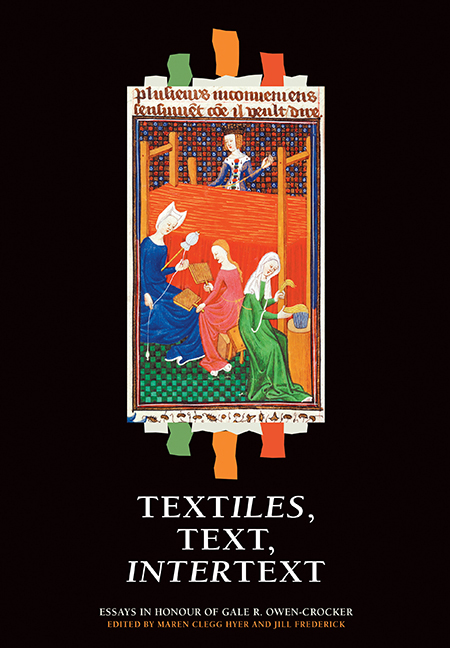Book contents
- Frontmatter
- Contents
- List of Illustrations
- List of Abbreviations
- Introduction
- A Personal Recollection
- List of publications of Gale R. Owen Crocker
- Part I Textile
- 1 The Language of Dress and Textiles in Wills of the Old English Period
- 2 Opus What? The Textual History of Medieval Embroidery Terms and Their Relationship to the Surviving Embroideries c. 800–1400
- 3 Intertextuality in the Bayeux Tapestry: The Form and Function of Dress and Clothing
- 4 Birds of a Feather: Magpies in the Bayeux Tapestry?
- 5 Threads and Needles: The Use of Textiles for Medical Purposes
- Part II Text
- Part III Intertext
- Index
- Tabula Gratulatoria
5 - Threads and Needles: The Use of Textiles for Medical Purposes
from Part I - Textile
Published online by Cambridge University Press: 05 July 2016
- Frontmatter
- Contents
- List of Illustrations
- List of Abbreviations
- Introduction
- A Personal Recollection
- List of publications of Gale R. Owen Crocker
- Part I Textile
- 1 The Language of Dress and Textiles in Wills of the Old English Period
- 2 Opus What? The Textual History of Medieval Embroidery Terms and Their Relationship to the Surviving Embroideries c. 800–1400
- 3 Intertextuality in the Bayeux Tapestry: The Form and Function of Dress and Clothing
- 4 Birds of a Feather: Magpies in the Bayeux Tapestry?
- 5 Threads and Needles: The Use of Textiles for Medical Purposes
- Part II Text
- Part III Intertext
- Index
- Tabula Gratulatoria
Summary
It is largely due to Gale R. Owen-Crocker that Anglo-Saxon textiles have moved from a marginal interest, studied by a few experts, to mainstream scholarship. From the outset Gale's work has been interdisciplinary, and she has reached out to many communities, including those outside academia. The success of her many projects is also based on the fact that she has managed to engage people who had hitherto not been terribly interested in textiles, and one of them was me. My very first academic appointment was as a research assistant on the Manchester Medieval Textile Project under the tutelage of Gale and Betty Coatsworth. The combination of research in textual study and material culture that I learned to use for the project changed the course of my own research.
This essay combines my current study into health and disease in Anglo-Saxon England with an interest in textiles that I gained during my years as a research assistant. It will consider the evidence for the use of textiles in medical and pharmacological procedures. Since there may be a difference between the “learned” discourse of Anglo-Saxon writers, who based their observations on a mixture of native and inherited traditions, and the application of medical knowledge in the communities outside monasteries, I will be looking at examples from both archaeology and literary sources. This approach has the advantage of comparing different domains, but we should be aware that much of the information for textile survival in a non-ecclesiastical environment comes from furnished burial, which was largely given up by the end of the seventh century. In many ways we are not comparing like with like, but, as with all types of early medieval evidence, there is a need to put the fragmented parts of the puzzle together.
Textiles, which are the products of a female economy during this period, are often overlooked in the discussions of medicine and healing in favour of the plants that were used, but they must have played an equally large role in the processes of healing. Since textiles are perishable, they most often have not survived the ravages of time, but the archaeological record does provide evidence of procedures that must have involved cloth for staunching wounds or binding bones, and thread for stitching wounds, and the textual record gives us word-clues for the same.
Information
- Type
- Chapter
- Information
- Textiles, Text, IntertextEssays in Honour of Gale R. Owen-Crocker, pp. 103 - 118Publisher: Boydell & BrewerPrint publication year: 2016
